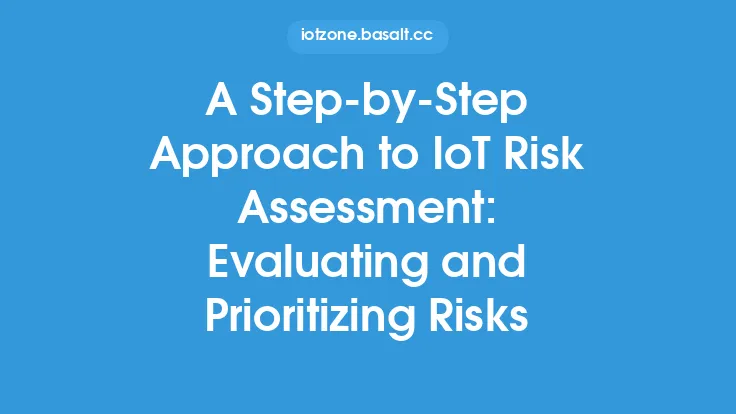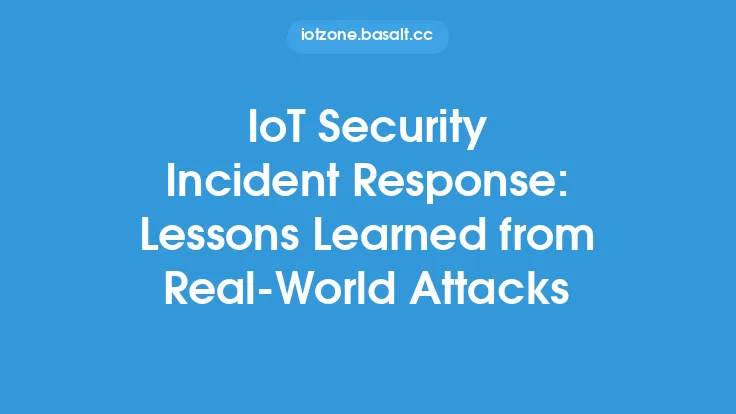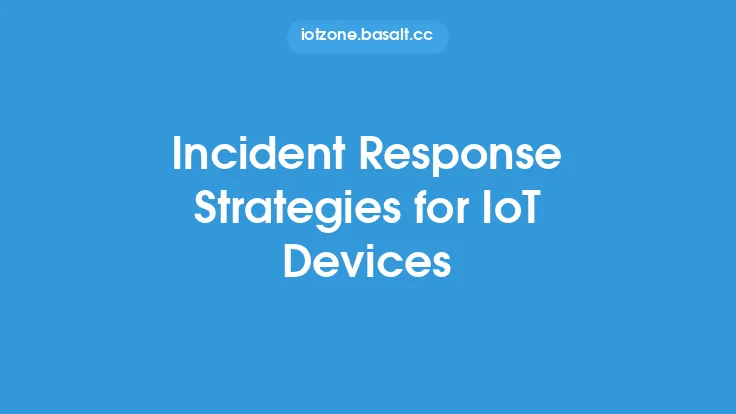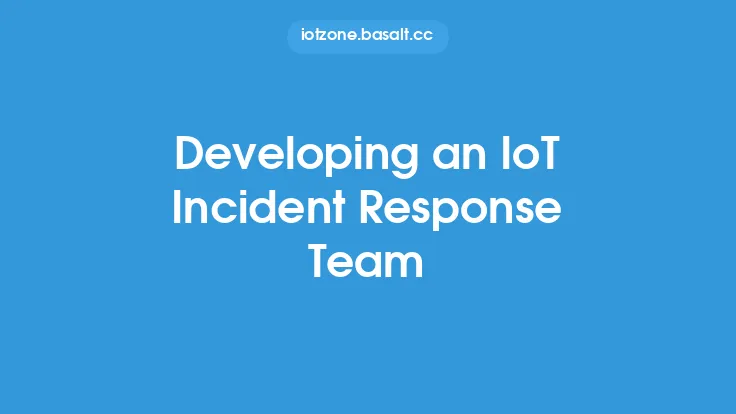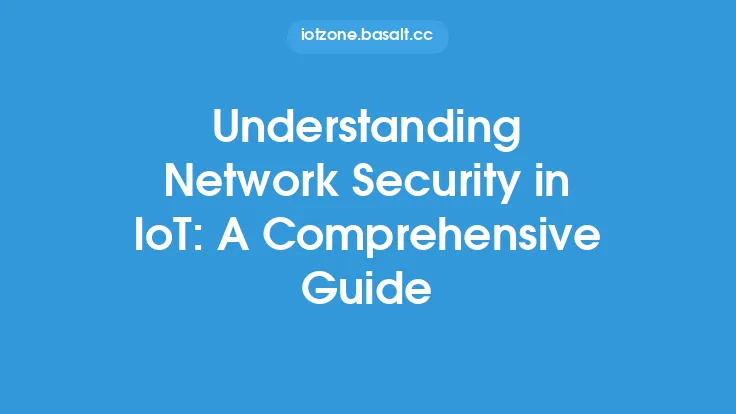Incident response is a critical component of any organization's security posture, and it's especially important in the context of IoT security. The increasing number of connected devices has created new vulnerabilities and attack surfaces, making it essential to have a well-planned incident response strategy in place. In this article, we'll provide a step-by-step guide on how to respond to IoT incidents, including preparation, detection, containment, eradication, recovery, and post-incident activities.
Preparation
Preparation is key to effective incident response. It involves having the necessary plans, procedures, and resources in place to respond quickly and efficiently in the event of an incident. The following are some steps to take during the preparation phase:
- Develop an incident response plan: This plan should outline the steps to take in the event of an incident, including the roles and responsibilities of the incident response team, communication protocols, and procedures for containment and eradication.
- Establish an incident response team: This team should consist of individuals with the necessary skills and expertise to respond to IoT incidents, including security professionals, network administrators, and device experts.
- Identify and prioritize IoT assets: Identify the IoT devices and systems that are critical to the organization's operations and prioritize them accordingly.
- Develop a threat intelligence program: This program should provide real-time threat intelligence on potential IoT threats, including vulnerabilities, malware, and other types of attacks.
- Conduct regular security assessments: Regular security assessments should be conducted to identify vulnerabilities and weaknesses in IoT devices and systems.
Detection
Detection is the process of identifying an incident as it occurs. The following are some steps to take during the detection phase:
- Monitor IoT devices and systems: Monitor IoT devices and systems for signs of suspicious activity, including unusual network traffic, device behavior, or system logs.
- Use threat intelligence: Use threat intelligence to stay informed about potential IoT threats and vulnerabilities.
- Implement intrusion detection systems: Implement intrusion detection systems to detect and alert on potential security threats.
- Conduct regular security audits: Conduct regular security audits to identify vulnerabilities and weaknesses in IoT devices and systems.
- Use machine learning and analytics: Use machine learning and analytics to identify patterns and anomalies in IoT device and system behavior.
Containment
Containment is the process of limiting the spread of an incident to prevent further damage. The following are some steps to take during the containment phase:
- Isolate affected devices: Isolate affected devices from the rest of the network to prevent the spread of malware or other types of attacks.
- Block malicious traffic: Block malicious traffic to prevent further damage.
- Disable affected services: Disable affected services or systems to prevent further damage.
- Implement temporary fixes: Implement temporary fixes, such as patches or workarounds, to mitigate the incident.
- Activate incident response protocols: Activate incident response protocols, including communication protocols and procedures for containment and eradication.
Eradication
Eradication is the process of removing the root cause of an incident. The following are some steps to take during the eradication phase:
- Identify the root cause: Identify the root cause of the incident, including the vulnerability or weakness that was exploited.
- Remove malware: Remove malware or other types of malicious code from affected devices.
- Apply patches: Apply patches or fixes to affected devices to mitigate the vulnerability or weakness.
- Restore systems: Restore systems and data from backups or other sources.
- Implement permanent fixes: Implement permanent fixes, such as patches or configuration changes, to prevent similar incidents in the future.
Recovery
Recovery is the process of restoring systems and data to a known good state. The following are some steps to take during the recovery phase:
- Restore systems: Restore systems and data from backups or other sources.
- Verify system integrity: Verify the integrity of systems and data to ensure that they are functioning correctly.
- Test systems: Test systems to ensure that they are functioning correctly and that the incident has been fully mitigated.
- Implement additional security controls: Implement additional security controls, such as firewalls or intrusion detection systems, to prevent similar incidents in the future.
- Conduct a post-incident review: Conduct a post-incident review to identify lessons learned and areas for improvement.
Post-Incident Activities
Post-incident activities are critical to ensuring that the incident is fully mitigated and that similar incidents are prevented in the future. The following are some steps to take during the post-incident phase:
- Conduct a post-incident review: Conduct a post-incident review to identify lessons learned and areas for improvement.
- Update incident response plans: Update incident response plans to reflect lessons learned and changes to the organization's security posture.
- Provide training: Provide training to incident response team members and other stakeholders on the lessons learned and changes to the incident response plan.
- Implement changes: Implement changes to the organization's security posture, including changes to policies, procedures, and technologies.
- Continuously monitor: Continuously monitor IoT devices and systems for signs of suspicious activity and stay informed about potential IoT threats and vulnerabilities.
Technical Considerations
When responding to IoT incidents, there are several technical considerations to keep in mind. The following are some of the key technical considerations:
- Device management: IoT devices often have limited management capabilities, making it difficult to detect and respond to incidents.
- Network segmentation: IoT devices often operate on separate networks, making it difficult to detect and respond to incidents that span multiple networks.
- Encryption: IoT devices often use encryption to protect data in transit, making it difficult to detect and respond to incidents that involve encrypted data.
- Secure coding practices: IoT devices often have limited resources, making it difficult to implement secure coding practices.
- Firmware updates: IoT devices often require firmware updates to patch vulnerabilities, making it difficult to keep devices up to date.
Tools and Technologies
There are several tools and technologies that can be used to support IoT incident response, including:
- Incident response platforms: Incident response platforms provide a centralized platform for managing incident response activities, including detection, containment, eradication, and recovery.
- Threat intelligence platforms: Threat intelligence platforms provide real-time threat intelligence on potential IoT threats and vulnerabilities.
- Security information and event management (SIEM) systems: SIEM systems provide real-time monitoring and analysis of security-related data from IoT devices and systems.
- Intrusion detection systems: Intrusion detection systems provide real-time monitoring and analysis of network traffic to detect and alert on potential security threats.
- Forensic analysis tools: Forensic analysis tools provide the ability to analyze IoT devices and systems to identify the root cause of an incident.
Conclusion
IoT incident response is a critical component of any organization's security posture. By following the steps outlined in this article, organizations can ensure that they are prepared to respond quickly and efficiently in the event of an IoT incident. Remember to stay informed about potential IoT threats and vulnerabilities, and continuously monitor IoT devices and systems for signs of suspicious activity. With the right plans, procedures, and resources in place, organizations can minimize the impact of IoT incidents and ensure the continuity of their operations.

